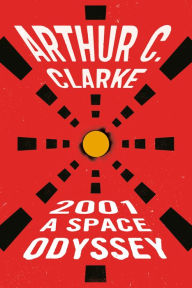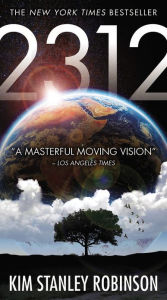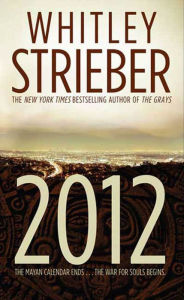7 Sci-Fi Books That Place Big Bets on a Specific Year
 Science fiction is all about speculation. Of course, plenty of sci-fi is set in the present-day or even the past, imagining things happening under the radar of history, secret realities we had no idea existed just behind the curtain. When sci-fi does peer into the future, most writers hedge their bets a little—an alternate universe here, a non-specific jump in time there—in order to avoid a future think piece discussing how wrong they were. Some sci-fi authors aren’t so scared, though. They not only bet on a specific year in their books—they put it in the title, leaving them no wiggle room. The brave writers of these eight books plant their flag in the future and dare it to not happen.
Science fiction is all about speculation. Of course, plenty of sci-fi is set in the present-day or even the past, imagining things happening under the radar of history, secret realities we had no idea existed just behind the curtain. When sci-fi does peer into the future, most writers hedge their bets a little—an alternate universe here, a non-specific jump in time there—in order to avoid a future think piece discussing how wrong they were. Some sci-fi authors aren’t so scared, though. They not only bet on a specific year in their books—they put it in the title, leaving them no wiggle room. The brave writers of these eight books plant their flag in the future and dare it to not happen.
Debug Notice: No product response from API
New York 2140, by Kim Stanley Robinson
Robinson’s vision of a plausibly soggy future New York is remarkable in the way it combines both pessimism and optimism about the future of humanity. On the one hand, the water levels have risen and swamped New York City, and the world at large is much changed, and not for the better (food shortages, millions upon millions of refugees, shorelines turned to toxic soup). On the other, Robinson imagines the survivors of climate change have figured out ways to keep living. Business still gets done. People still live in the submerged city, just…higher-up. Personal dramas still play out. Where many writers imagine ecological disaster will be the end of civilization as we know it, Robinson sees profound change, but not necessarily an ending. The year he’s chosen for his setting—2140—is kind of an ideal period of time: far enough into the future to seem remote—remote enough that none of us will live to see it, anyway. (Yes, we know: Robinson’s 2312 also qualifies…keep reading.)
New York 2140, by Kim Stanley Robinson
Robinson’s vision of a plausibly soggy future New York is remarkable in the way it combines both pessimism and optimism about the future of humanity. On the one hand, the water levels have risen and swamped New York City, and the world at large is much changed, and not for the better (food shortages, millions upon millions of refugees, shorelines turned to toxic soup). On the other, Robinson imagines the survivors of climate change have figured out ways to keep living. Business still gets done. People still live in the submerged city, just…higher-up. Personal dramas still play out. Where many writers imagine ecological disaster will be the end of civilization as we know it, Robinson sees profound change, but not necessarily an ending. The year he’s chosen for his setting—2140—is kind of an ideal period of time: far enough into the future to seem remote—remote enough that none of us will live to see it, anyway. (Yes, we know: Robinson’s 2312 also qualifies…keep reading.)
Debug Notice: No product response from API
1984, by George Orwell
Orwell achieved something very few writers who dabble in specific dates ever manage: he took a year and transformed it into a concept. While Orwell’s experiment in extrapolation wasn’t particularly accurate, his work is so profound and well-imagined it doesn’t matter; 1984 has become the codeword for totalitarianism, tyranny, and the oppressive potential of modern technology. Orwell did such a good job, in fact, that all anyone has to do is say “1984” as a comment on any situation, and everyone knows precisely what they’re talking about. For extra points, track down a copy of Anthony Burgess’ tough-to-find 1985, a novella written partly as a response to Orwell’s work, and partly as a repetition of Orwell’s experiment in following trends to imagine the future.
1984, by George Orwell
Orwell achieved something very few writers who dabble in specific dates ever manage: he took a year and transformed it into a concept. While Orwell’s experiment in extrapolation wasn’t particularly accurate, his work is so profound and well-imagined it doesn’t matter; 1984 has become the codeword for totalitarianism, tyranny, and the oppressive potential of modern technology. Orwell did such a good job, in fact, that all anyone has to do is say “1984” as a comment on any situation, and everyone knows precisely what they’re talking about. For extra points, track down a copy of Anthony Burgess’ tough-to-find 1985, a novella written partly as a response to Orwell’s work, and partly as a repetition of Orwell’s experiment in following trends to imagine the future.
2001: A Space Odyssey (Space Odyssey Series #1)
2001: A Space Odyssey (Space Odyssey Series #1)
In Stock Online
Paperback $8.99
2001: A Space Odyssey, by Arthur C. Clarke
While there are significant differences between the novel and Stanley Kubrick’s film adaptation, each shares one element: their completely inaccurate prediction of the future. Writing in 1968 when the world was on the cusp of sending men to the moon, it was likely easy for Clarke and Kubrick to imagine space exploration would naturally gain momentum, sending men out into the solar system on a regular basis. While both the film and the novel remain compelling visions of a possible future past, both are clear cases of creators betting on a year and losing. Not only was 2001 nothing like Clarke’s vision, the sequel, 2010, didn’t fare any better. The novels 2061 and 3001 might still win the day, though—stay tuned.
2001: A Space Odyssey, by Arthur C. Clarke
While there are significant differences between the novel and Stanley Kubrick’s film adaptation, each shares one element: their completely inaccurate prediction of the future. Writing in 1968 when the world was on the cusp of sending men to the moon, it was likely easy for Clarke and Kubrick to imagine space exploration would naturally gain momentum, sending men out into the solar system on a regular basis. While both the film and the novel remain compelling visions of a possible future past, both are clear cases of creators betting on a year and losing. Not only was 2001 nothing like Clarke’s vision, the sequel, 2010, didn’t fare any better. The novels 2061 and 3001 might still win the day, though—stay tuned.
2312
2312
Paperback $10.00
2312, by Kim Stanley Robinson
Robinson, as fearless as they come, likes to double-down on his double-downing. In 2312, he doesn’t skimp on the future-framing, declaring that by that far-off year, humanity will have spread throughout the solar system, leveraging incredible feats of scientific and engineering achievement to live in every possible environment—including a city on Mercury that moves continuously to avoid the deadly, unfiltered rays of the sun. Robinson balances his epic universe-building with a tightly-plotted mystery, kicked off when artist and asteroid designer Swan Er Hong’s grandmother dies under suspicious circumstances. Worth noting that the circa-2300 New York Swan visits is likewise more of a New Venice; we won’t be here to see how close Robinson’s imagination is to reality, but it’s nice to see an author so committed to his timeline.
2312, by Kim Stanley Robinson
Robinson, as fearless as they come, likes to double-down on his double-downing. In 2312, he doesn’t skimp on the future-framing, declaring that by that far-off year, humanity will have spread throughout the solar system, leveraging incredible feats of scientific and engineering achievement to live in every possible environment—including a city on Mercury that moves continuously to avoid the deadly, unfiltered rays of the sun. Robinson balances his epic universe-building with a tightly-plotted mystery, kicked off when artist and asteroid designer Swan Er Hong’s grandmother dies under suspicious circumstances. Worth noting that the circa-2300 New York Swan visits is likewise more of a New Venice; we won’t be here to see how close Robinson’s imagination is to reality, but it’s nice to see an author so committed to his timeline.
Revolt in 2100
Revolt in 2100
In Stock Online
eBook $4.99
Revolt in 2100, by Robert A. Heinlein
This set of linked stories collectively tells the tale of a future America fallen into theocracy and tyranny, sparking a Second American Revolution to throw off the yolk of fundamentalist religious zealots, and the immediate aftermath of that battle. Interestingly, some of the stories set after the revolution depict the resulting society from the point of view of characters who are unhappy about this course of events, and who reject the new secular society that rises from the chaos. There’s only a few decades to go before the year 2100, so there’s still plenty of time to see a theocracy take power. The line on Heinlein being an accurate prognosticator remains pretty much 50-50.
Revolt in 2100, by Robert A. Heinlein
This set of linked stories collectively tells the tale of a future America fallen into theocracy and tyranny, sparking a Second American Revolution to throw off the yolk of fundamentalist religious zealots, and the immediate aftermath of that battle. Interestingly, some of the stories set after the revolution depict the resulting society from the point of view of characters who are unhappy about this course of events, and who reject the new secular society that rises from the chaos. There’s only a few decades to go before the year 2100, so there’s still plenty of time to see a theocracy take power. The line on Heinlein being an accurate prognosticator remains pretty much 50-50.
2012: The War for Souls
2012: The War for Souls
In Stock Online
eBook $7.99
2012, by Whitley Strieber
Remember when the Mayan Calendar predicted December 2012 would put us smack in the middle of the End Times? Ah, the good old days, when the mere end of the world was our biggest worry. Strieber’s sequel to The Grays starts with that pivotal date to spin out a tale combining parallel earths, the literal existence of the human soul, and a desperate struggle to stop alien invaders from the former from arriving to devour the latter. While no one would accuse Strieber of making any sort of serious predictions, it is fascinating to note that 2012 came and went without so much as one soul being devoured, at least as far as anyone can tell.
2012, by Whitley Strieber
Remember when the Mayan Calendar predicted December 2012 would put us smack in the middle of the End Times? Ah, the good old days, when the mere end of the world was our biggest worry. Strieber’s sequel to The Grays starts with that pivotal date to spin out a tale combining parallel earths, the literal existence of the human soul, and a desperate struggle to stop alien invaders from the former from arriving to devour the latter. While no one would accuse Strieber of making any sort of serious predictions, it is fascinating to note that 2012 came and went without so much as one soul being devoured, at least as far as anyone can tell.
Delphi Complete Works of Jules Verne
Delphi Complete Works of Jules Verne
By Jules Verne
In Stock Online
eBook $2.99
Honorable Mention: In the Year 2889, by Jules Verne
Verne, most agree, didn’t actually write this story—his son Michel probably did, working from his father’s notes. It’s set in what would have been 1,000 years in the future in Verne’s day, and recounts a day in the life of a journalist, detailing all the incredible changes that have occurred, including huge cities filled with tens of millions of people who travel via pneumatic tube at speeds reaching 1,000 miles per hour. Everyone gets their information via phonograph while living in apartments that are single rooms that transform at the push of a button. Remarkably, most of Verne’s predictions have already come true in one form or another; if he’d titled the work In the Year 1989, he might have gotten a lot more credit.
Honorable Mention: In the Year 2889, by Jules Verne
Verne, most agree, didn’t actually write this story—his son Michel probably did, working from his father’s notes. It’s set in what would have been 1,000 years in the future in Verne’s day, and recounts a day in the life of a journalist, detailing all the incredible changes that have occurred, including huge cities filled with tens of millions of people who travel via pneumatic tube at speeds reaching 1,000 miles per hour. Everyone gets their information via phonograph while living in apartments that are single rooms that transform at the push of a button. Remarkably, most of Verne’s predictions have already come true in one form or another; if he’d titled the work In the Year 1989, he might have gotten a lot more credit.




